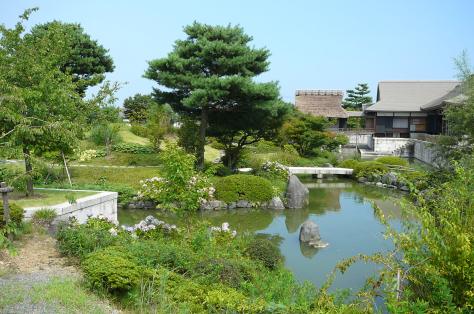Recent times have seen a revival of local festivals in Japan, especially in the rural areas, probably because people wanted to forget the sluggish economy and come back to more basic social gatherings after long years spent away in dehumanizing cities.
My good friend Neil had mentioned that his neighborhood in Miwa was organizing their 5th Annual Sakura Festival yesterday so I rode my bicycle for a good 45 minutes from home till the other side of the Abe River in Shizuoka City!
I left my bicycle at Neil’s place and walked till the Miwa Primary School where I found this banner announcing the Cherry Blossoms Festival!
For once that the weather was fine I walked on the causeway along the Abe River.
It is still winter and the water was pretty dry in all senses of the word!
I finally espied the site!
The Festival has been scheduled on the 3rd Sunday of February whatever the conditions or weather.
Unfortunately the last three weeks have witnessed unseasonal cold and the early-blooming Kawazu Cherry Trees had not blossomed yet!
For a closer view!
On the other hand the Japanese plum trees were still very much in flowers!
And the kumquats were everywhere for a picking!
We are full in leek season! Great to fight colds!
Plenty of beautiful colors to be found in private gardens!
But someone had made sure we had some cherry blossoms on site!
Neil had been designated as the sound engineer of the event!
You can’t have a festival in Japan without drums!
I wonder what those fox masks are for!
Robust ladies!
Oranges and tea on sale!
Notice the “dustbins”!
The site was small but certainly crowded!
Local bonsai on sale!
Local farmers selling their produce!
What are they preparing here?
Tonjiru soup for free!
Very thoughtful of the organizers!
Ashikubo Green Tea!
Sweet dango/balls!
Boxed lunches and wagashi cakes!
Chirashizushi bento!
All bentos are really home-made before put on sale!
Okonomiyaki!
Grilled sausages!
Deep-fried sweetmeat buns!
Yakisoba!
Candy Floss!
Grilled mochi cakes!
Local Benihoppe strawberries!
Home-made umeboshi!
They even had a small flea market!
Oden!
Dorayaki!
Very traditional dance!
Another very traditional dance!
And very traditional drinking!
RECOMMENDED RELATED WEBSITES
Francescannotwrite, My White Kitchen, 47 Japanese Farms Through The Eyes of Its Rural Communities, Foodhoe, Chucks Eats, Things that Fizz & Stuff, Five Euro Food by Charles,Red Shallot Kitchen by Priscilla,With a Glass, Nami | Just One Cookbook, Peach Farm Studio, Clumsyfingers by Xethia, PepperBento,Adventures in Bento Making, American Bent, Beanbento, Bento No, Bento Wo Tsukurimashou, Cooking Cute, Eula, Hapabento , Happy Bento, Jacki’s Bento Blog, Kitchen Cow, Leggo My Obento, Le Petit Journal Bento & CO (French), Lunch In A Box,
Susan at Arkonlite, Vegan Lunch Box; Tokyo Tom Baker, Daily Food Porn/Osaka, Only Nature Food Porn, Happy Little Bento, The Herbed Kitchen, J-Mama’s Kitchen, Cook, Eat, Play, Repeat, Bento Lunch Blog (German), Adventures In Bento, Anna The Red’s Bento Factory, Cooking Cute, Timeless Gourmet, Bento Bug, Ideal Meal, Bentosaurus, Mr. Foodie (London/UK), Ohayo Bento,
Must-see tasting websites:
-Sake: Tokyo Through The Drinking Glass, Tokyo Foodcast, Urban Sake, Sake World
-Wine: Palate To Pen, Warren Bobrow, Cellar Tours, Ancient Fire Wines Blog
-Beer: Good Beer & Country Boys, Another Pint, Please!
-Japanese Pottery to enjoy your favourite drinks: Yellin Yakimono Gallery























































